

2018 North Atlantic Right Whale Injury Report
February 12, 2019
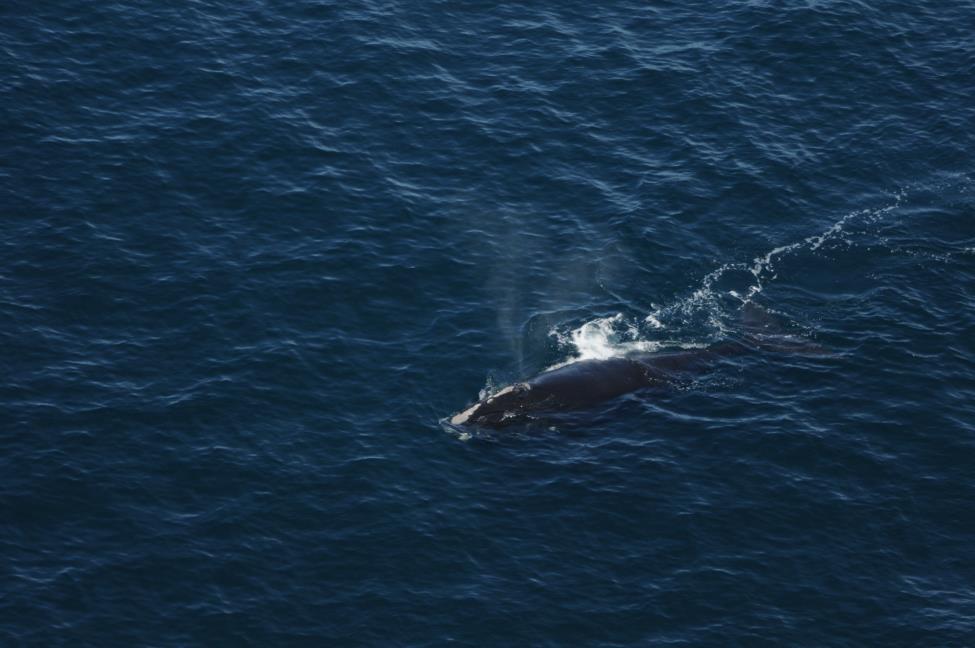
North Atlantic right whale #4091, a 9 year old female, swims off the coast of southern New England on April 16, 2015. In the spring of 2018, she was sighted 60 miles off the coast of Chatham, Massachusetts entangled in fishing rope.
credit: New England Aquarium
The North Atlantic Right Whale Consortium (NARWC) 2018 Report Card [PDF] has been released and we have reviewed the Live Vessel Strikes, Entanglements and Entrapments section. Unfortunately, we have found out that there were some injuries that we did not previously hear about. We did post about all three of the known deaths that occurred in 2018, and some of the injuries that we heard about during 2018, but we would be remiss if we didn't cover all of the whales that were seen injured last year. There have also been articles about how no North Atlantic right whales were found dead in Canadian waters in 2018. This
is true and is a significant improvement over 2017 when there were 12 known deaths in Canadian waters but it's not the full story. The first death of 2018 occurred off the coast of Virginia when North Atlantic right whale #3893, a 10 year old female just entering reproductive age, was killed by an entanglement in fishing rope. She was last seen alive on July 29, 2017 in the Gulf of St. Lawrence before she was found wrapped in the rope that killed her on January 22, 2018. The gear was later found to be from the snow crab fishery in Canada so although this death did not occur in Canadian waters it was from Canadian fishing gear.[PDF] The other two known deaths also occurred in American waters and were caused by entanglements but the origin of the rope that killed them is unknown because it was not on the whales when they were found. The identities of those whales are also unknown due to the advanced state of decomposition they were in when they were found.
There were also at least three entanglements of living whales reported in Canadian waters in 2018, one of which definitely occurred in the Gulf of St. Lawrence, another that most likely occurred in that area and one whale was seen in the Bay of Fundy with an entanglement, the origin of which is unknown at this time. There was also a bad ship strike injury reported in the Gulf of St. Lawrence although it's unknown where exactly the whale was struck. These injuries and the death of #3893 cast a shadow over the news that no whales were found dead in Canadian waters in 2018. We have documented the known injuries of 2018 below and list the most recent status of their condition. One of the most important things we use to get information on these whales is the New England Aquarium's North Atlantic Right Whale Catalog - a search for their catalog numbers there will provide more pictures and information on each whale we list in this report. The suffering of these whales cannot go unnoticed and their stories must be told so we have decided to do an annual report on what we know about any injured whales that were seen during the year. In doing this we can keep track of these whales and their status, out of respect for them and to learn what we can to prevent this suffering in the future.
Ship Strikes
#4145, a 8 year old male, was seen on March 1, 2018 in Cape Cod Bay with a new injury that, "consists of small prop cuts on dorsal left fluke and left trailing edge. Skeg marks on dorsal left fluke and left body. Wounds do not appear to be fresh. There are no visual indicators that the injury has impacted health thus far." He is the 2011 calf of Slalom (#1245), a 37 year old right whale who has been entangled in fishing gear at least once in her life. His grandmother, Wart (#1140), has also been entangled at least once.

North Atlantic right whale #4145 feeding in Cape Cod Bay on April 17, 2012 when he was just 1 year old.
credit: Center for Coastal Studies
Another North Atlantic right whale, whose identity was unable to be ascertained, did not fare so well with the ship that struck them. The whale was seen in the Gulf of St. Lawrence on July 11, 2018 with propeller marks that were behind and across the blowholes. The NARWC wrote, "Condition of whale is poor with grey skin, increased orange cyamid load on body, and compromised body condition visible from air. Whale was resighted in August 2018 in similar condition."
If whales are visibly thinner then the chance they will be seen if they die is diminished because the lack of blubber causes them to sink faster. This is believed to be the case with Snowball (#1131), a North Atlantic right whale who was seen in June of 2014 with a severe entanglement and in terrible condition. Philip Hamilton, research scientist at the New England Aquarium, stated in a post, "Snowball has almost certainly died since his June 2014 sighting—having slowly succumbed to infection or starvation, or both. His emaciated body would likely not have floated, sinking to the bottom of the ocean and leaving no chance of someone reporting his carcass." This is why we look deeper into the list of injuries as some of the badly injured whales are never seen again and were most likely killed by the injury that they were first sighted with.
It's always bad when a whale is found dead but at least if they're found then the death can be recorded, investigated and remembered. If a whale dies unseen then it's easy for the possible cause of death to be swept under the rug. If the whale was last seen with a bad entanglement then that could have been the cause of death but we're sure the fishing industry would be the first to cast doubt on the claim in order to try to avoid any responsibility. It's also easy for a whale, and the struggle they went through, to be forgotten if their death goes unseen. Their plight, and the plight of their fellow whales, is already not as easily seen and known about because they live offshore in the oceans away from most humans. Their suffering must be learned from so we can work to prevent it in the future but that can't happen if they're forgotten about.
Entanglements
#1142, a well-known female who is at least 42 years old and the mother, grandmother or great-grandmother to 23 right whales (about 5% of the population), was first seen entangled in 2014 off the coast of New Jersey and was resighted on 4/10/2018 and 4/12/2018 in Stellwagen Bank off the coast of Massachusetts, still entangled. The NARWC reports, "A disentanglement team was able to partially cut both lines exiting the right side of her mouth. The hope is that the damage to the ropes will deteriorate the strength of the line over time. Whale was re-sighted on 6/19/2018, 7/12/2018, 7/19/2018 and 7/20/2018 in the Gulf of St. Lawrence, still entangled. Her condition deteriorated markedly between June and July." This is at least the second time she has been entangled in fishing gear in her life.
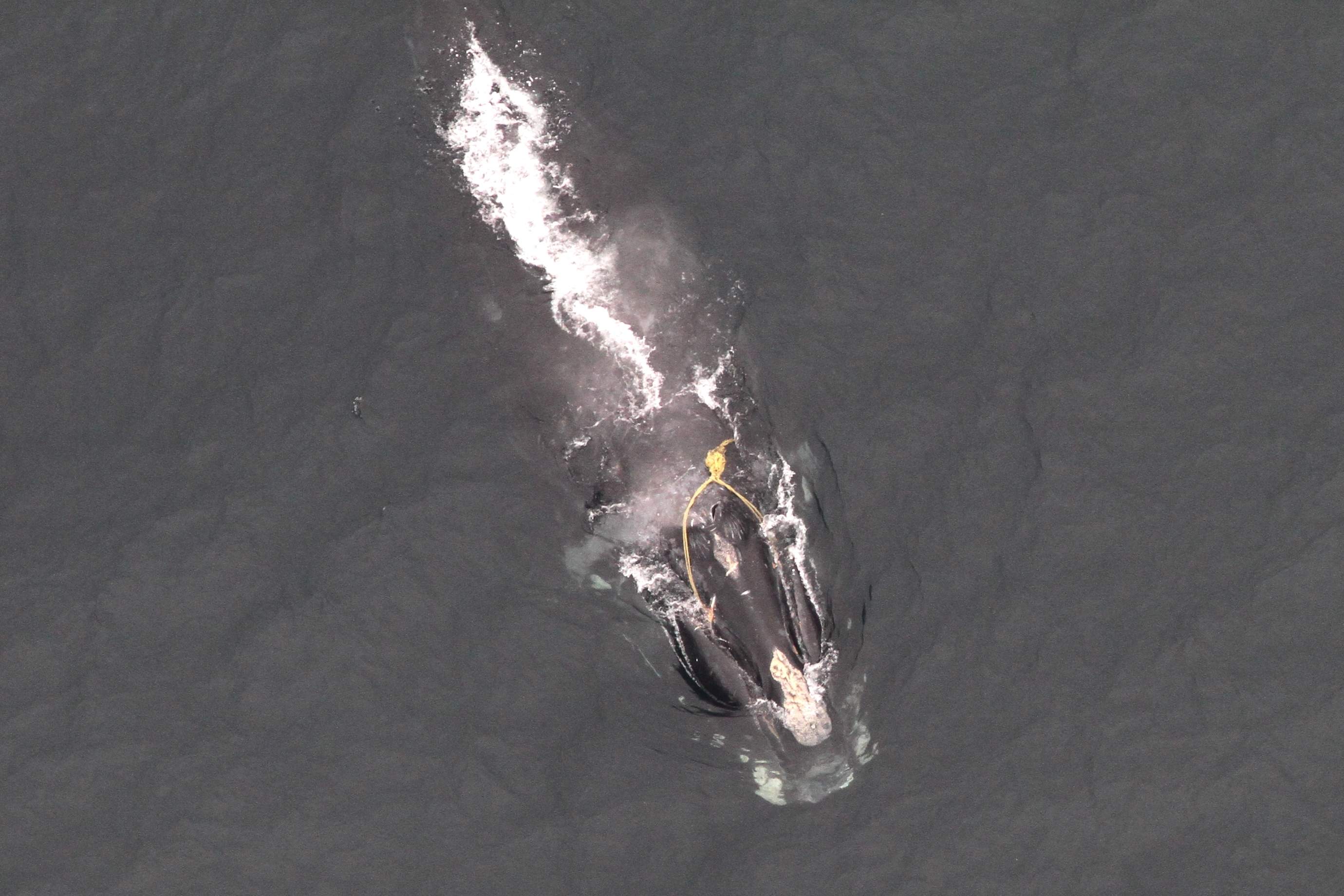
North Atlantic right whale #1142 was photographed during an aerial survey in Stellwagen Bank off the coast of Massachusetts on April 10, 2018. She has been entangled in that rope since at least 2014.
credit: Peter Duley, NEFSC, permit #17355
#4091, a 9 year old female (just one year away from the age females usually begin calving), was sighted on May 12, 2018, 60 miles ESE of Chatham, Massachusetts entangled in rope. The NARWC reports, "The whale has line wrapped around its right flipper, at minimum, with about 50ft green line trailing. What appears to be a red, yellow and green buoy is near the right flipper. Due to weather forecast and distance, the CCS response team could not mount a response. Whale has not been resighted." She is one of the nine grand-calves of #1142 as her mother is Echo (#2642), the 1996 calf of #1142. #4091 already has scars from a previous entanglement and what appear to be propeller scars, both of which occurred sometime before the summer of 2014. Her mother, Echo, has scars from what appears to be at least one previous entanglement in rope.

North Atlantic right whale #4091 photographed in the Great South Channel, 60 miles southeast of Chatham, MA on May 12, 2018 with rope visible on her right flipper just below the surface.
credit: NEFSC

North Atlantic right whale #4091 photographed in the Great South Channel, 60 miles southeast of Chatham, MA on May 12, 2018 with rope trailing from her right flipper just below the surface.
credit: NEFSC
#3312, a 16 year old male, was seen on July 13, 2018 with a bad entanglement in the Gulf of St. Lawrence. We reported on his entanglement at the time and knew it was bad but new information shows that it was worse than we first thought. The NARWC report states, "Aerial survey team sighted whale with gear in tow. Whale had been seen by the same team earlier in the day gear free. At minimum, the whale had yellowish line through the mouth and trailing at least a few body lengths behind. One of the trailing lines may sink and the aerial team noticed what may have been floats or tackle subsurface. The whale appeared agitated, and was writhing at the surface and defecating. Raw rope burns were apparent across the back and peduncle. Whale has not been resighted."
This is a particularly disturbing report but it does give us some crucial facts. The whale was seen gear-free earlier in the day so even though the whale has not been resighted and the gear has not been retrieved, we still know it occurred in the Gulf of St. Lawrence somewhere close to where the whale was first seen entangled. There were at least seven new fishing area closures in Canadian waters during the month of June alone but it was still not enough to prevent this entanglement. The fact that #3312 has not been resighted is upsetting, especially considering the severity of the entanglement. He already has scars from a previous entanglement in fishing gear that occurred sometime before March of 2008 and his mother, #1612, has extensive scarring from at least one previous entanglement in fishing rope.
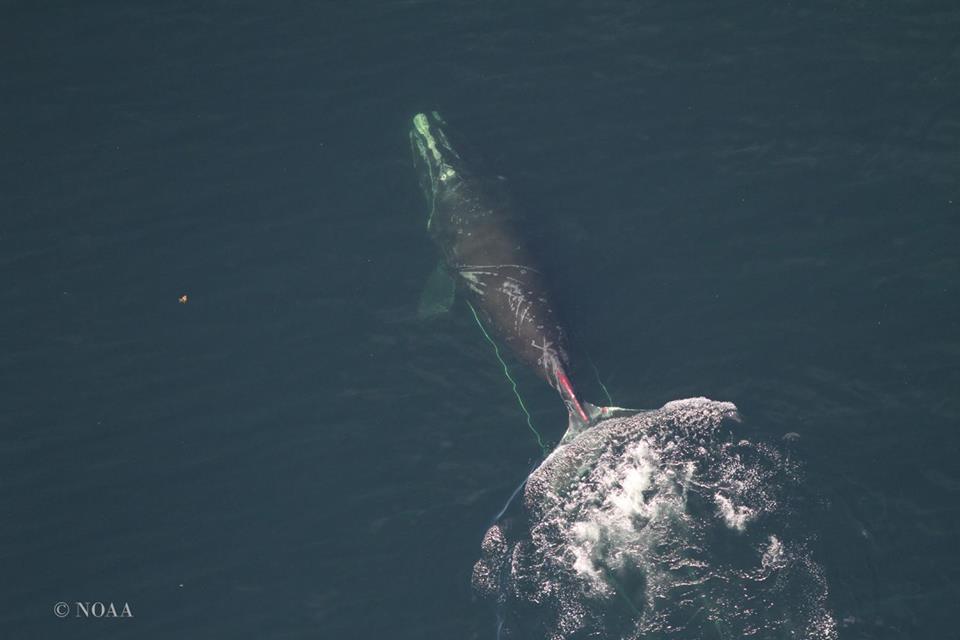
North Atlantic right whale #3312 near Miscou Island in the Gulf of St. Lawrence with fresh wounds caused by an entanglement in fishing gear
Photo credit: NOAA, via Marine Animal Response Society
#3843, a 11 year old male, was seen on July 30, 2018 in the Bay of Fundy, "trailing a buoy approx. one body length aft of the flukes. Whale was very thin and had severe wounds and significant aggregations of cyamids around the peduncle. Whale was partially disentangled on 8/5/2018 (including the attached buoy). There is likely some remaining line on the whale that will hopefully shed over time. Resighted on 12/30/2018 southeast of Nantucket. Line remains, exiting left mouth and there may be a rostrum wrap." We are glad that some of the gear was removed and that he has continued to survive but the fact that some of the rope remains is very concerning.
We wrote about his partial disentanglement shortly after it happened and quoted Scott Landry, director of the Marine Animal Entanglement Response program at the Center for Coastal Studies in Provincetown, Massachusetts. He had looked at photographs of #3843 that were taken since he became entangled and compared them to photos taken in June when he was seen in the Gulf of St. Lawrence and was taken aback by the level of deterioration of the whale's health. He noted that the whale was pale and had lost weight, with cyamids, known as whale lice, all over his body and stated, "There's obviously something very, very severe about this entanglement" and that the whale was in terrible pain. The partial disentanglement of #3843 was the first rescue of a North Atlantic right whale in Canada since the death of Joe Howlett, one of the founders of the Campobello Whale Rescue Team, who was killed during the disentanglement of a right whale on July 10, 2017. The Canadian government had put a halt to all disentanglements of right whales that was finally lifted in March of 2018.
The most recent sighting of #3843 on December 30, 2018 was during an aerial survey by the Northeast Fisheries Science Center (NEFSC) that found a total of 53 North Atlantic right whales southeast of Nantucket, one of many sightings of large groups of right whales in recent months in that area. We thought it was great that none of the whales were reported to be entangled at the time but now we see it was too good to be true. We wish that the news of this latest sighting of #3843 had been released earlier but it's possible that the government shutdown affected the release of the news as some employees were furloughed and entire NOAA websites were shut down for weeks. His mother is a right whale named Magic (#1243), the 1982 calf of #1242.

North Atlantic right whale #3843 in the Gulf of St. Lawrence on June 6th, 2018
credit: Peter Duley, NOAA/NEFSC
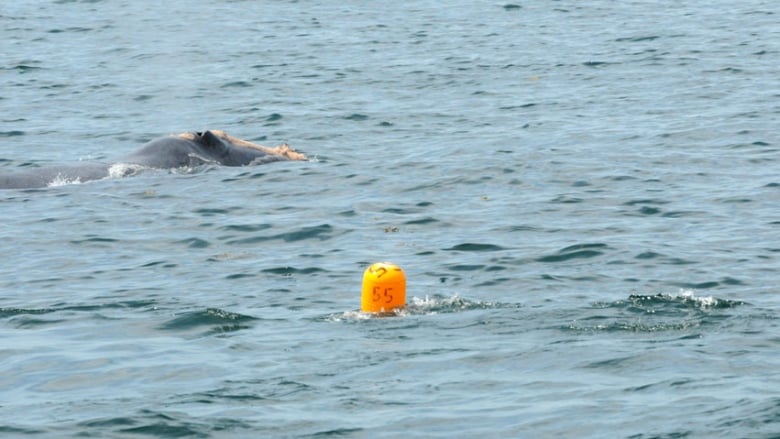
#3843 in late July, entangled and trailing a buoy. His back is sunken in, clearly showing that he is emaciated.
credit: New England Aquarium
#3960, a 10 year old male, was seen on August 20, 2018 in the Gulf of St. Lawrence with a nasty entanglement. The NARWC reported, "Whale observed with multiple wraps of the rostrum, damaged baleen, and no line trailing, although the sighting team felt that there was likely weight attached. Throughout the sighting the whale was thrashing at the surface and the configuration of the entanglement changed often. This behavior, the condition of the whale and changing entanglement configuration, led the team to believe that it was likely a new entanglement. As the team on scene was consulting and documenting the whale, its entanglement configuration continued to change and the whale picked up speed swimming at ~8kts. After more observations, the team felt that the whale might have shed the entanglement. No additional sightings of this whale have been reported. While observers noted that no gear was visible at the end of the sighting, they could not see all body areas and the whale was relatively distant and therefore the whale is considered still entangled."
Although the sighting team felt that the whale could have shed the rope, the entanglement was severe and could still be affecting the whale. It's also important to note that the team felt it was a new entanglement which meant that it most likely occurred in the Gulf of St. Lawrence. As of July 20th, a month before #3960 was seen entangled, there were at least 20 fishing area closures that had been implemented in Canadian waters yet this entanglement still most likely occurred in Canada, possibly making it the second known entanglement of 2018 in the Gulf of St. Lawrence. #3960 has scars from at least one previous fishing gear entanglement. His mother, Slash (#1303), was first seen in 1979 and also had scars from at least one previous entanglement but was found dead off the coast of Virginia on March 17, 2011. Her cause of death is unknown as she was unable to be relocated for a necropsy. #3960 was the last calf she gave birth to before she died.

#3960 swims in Cape Cod Bay on March 23, 2012, his scars from a previous entanglement can be seen at the base of his flukes
credit: Center for Coastal Studies via NEAQ Right Whale Catalog

North Atlantic right whale #1303, known as Slash, swims with her calf (#3960) when he was no more than a few months old off the coast of Florida on March 9, 2009.
credit: New England Aquarium
#2310, a male who is at least 26 years old, was sighted on December 20, 2018 southeast of Nantucket with an entanglement. The NARWC reports, "The whale appears to have a short bitter end at the area of its left pectoral flipper that enters its left mouth. The line passes through the mouth and exits out the right side, trailing roughly 1-2 body lengths, at minimum, aft of the flukes. It appears as though the trailing line sinks into the water column due to the nature of the line, no bitter end was observed. There were no significant injuries associated with the entanglement documented. The whale was slightly thin. A response was not mounted. The whale may shed the line on its own." Thankfully this does not appear to be as severe of an entanglement as some of the others seen in 2018 but is still concerning nonetheless. #2310 was one of 29 North Atlantic right whales sighted southeast of Nantucket on December 20th, one of at least two whales seen with entanglements during aerial surveys in that area in December (#3843 is the other whale and was seen on December 30th). Aerial surveys are very important because they let researchers and regulators know where whales are so that protection measures can potentially be implemented in those areas. They are also key because they can gauge the health of the group and of individual whales, especially those who are entangled so researchers can develop a plan to help free the whale of their entanglement. The mother of #2310 is unknown.

North Atlantic right whale #2310 playing with another right whale off the coast of South Carolina on Feburary 21, 2010. North Atlantic right whales can be seen any time of the year gathering at the surface like this to socialize with other right whales.
credit: Sea to Shore Alliance
#3296, a 17 year old male, was seen badly injured and emaciated when he was photographed swimming south 30 miles east of Jekyll Island, Georgia on February 15, 2018. #3296 was last seen in good condition in Cape Cod Bay on April 30, 2017. Even though there was no rope present at the time of this sighting, entanglement in commercial fishing rope is suspected and most likely came off somehow before this sighting. The 2018 NARWC Report Card listed injuries that were caused by ship strikes and listed active fishing gear entanglements, along with information about injuries that were seen that we cover later in this report, but did not list the specific whales with injuries that were most likely caused by entanglements like this one. We feel that it's very important to list #3296 as well so that his plight doesn't go unnoticed and that the likely connection to entanglement is not ignored. Since there was no rope on him and he hasn't been seen since, it would be easy for his injury to be swept under the rug, especially by those who constantly rush to defend the fishing industry, but we can't let that happen.
#3296 already had scars from a fishing gear entanglement that happened sometime before 2008 so this was at least his second entanglement. #3296's mother, a whale named One-Two (#1430), was entangled in rope at least twice in her life as well. The first entanglement left severe scars at the base of her flukes and she was later seen entangled in rope on June 7, 2003 in George's Bank off the coast of New England - this is her last recorded sighting and she is most likely dead, possibly from complications due to the entanglement. She went missing a little over a year after giving birth to #3296 in 2002 and now the last calf she had is in terrible shape and has possibly died since his last sighting on February 15, 2018.

North Atlantic right whale #3296, healthy and swimming in Cape Cod Bay on March 21, 2017.
credit: Woods Hole Oceanographic Institute

North Atlantic right whale #3296 is seen here badly injured and emaciated, swimming south 30 miles east of Jekyll Island, Georgia on February 15, 2018.
credit: Sea to Shore Alliance, permit #20556 via Georgia DNR Flickr
In addition to the grim news like this that we have the responsibility to report, we can thankfully say that there was also some good news from 2018: two of the North Atlantic right whales that were seen entangled in 2017 were observed to be free of the rope that entangled them when they were sighted again in 2018.
#4146, a 8 year old female, was sighted in Cape Cod Bay on April 23, 2017 with an entanglement. The NARWC reports, "Length of yellowish line caught in the left side of the mouth. The line is doubled on itself and trails aft of the flukes by about a body length. There appears to be a jumble of line and/or netting near the end of the trailing gear. Disentanglement response unable to work whale. Resighted gear free on 4/22/2018 in Cape Cod Bay." This is excellent news and means she somehow managed to shed the rope on her own. #4146 already has propeller scars on her left side from when she was struck by a boat sometime between August 17, 2011 and January 17, 2012. Her mother (#2746) was born in 1997 and has extensive scarring from at least one previous fishing gear entanglement, her grandmother (#1946) was born in 1989 and has scars from at least one entanglement and her great-grandmother (Loligo #1246), birth year unknown, also has scars from at least one entanglement.
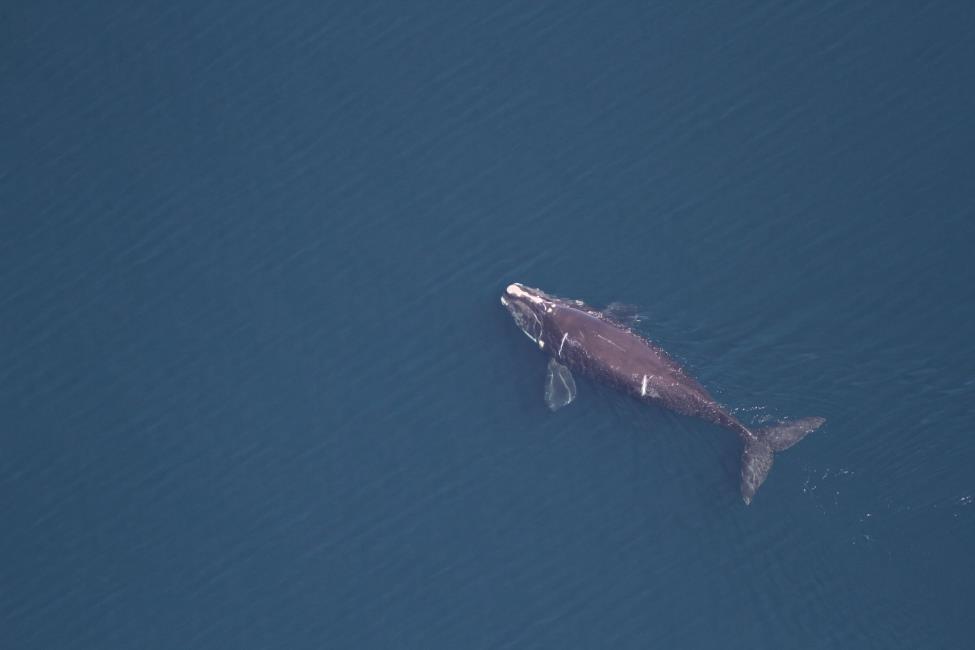
North Atlantic right whale #4146 swimming in Cape Cod Bay a little over a year after she was born, propeller scars from a ship strike are visible on her left side.
credit: Center for Coastal Studies
#3245, a 17 year old male, was seen about 20 miles east of Perce on the Gaspe Peninsula in Quebec on August 28, 2017 with a very bad entanglement. The NARWC described it as follows, "Whale entangled in what appears to be heavy line. Type unknown. The whale was essentially hogtied, with line through its mouth, leading to wraps of the peduncle. The whereabouts of any bitter ends are unknown but based on behavior and line impressed into the right flank, it appears the line leads to heavy weight. No disentanglement response permitted. Whale resighted 10/29/2017 in GoSL [Gulf of St. Lawrence] skim feeding. Remained unclear whether the whale was gear free at this time. It was, however, apparent that if gear was still present, the configuration had changed as there was no obvious line observed over the back or wrapped around the peduncle. Resighted again in Jan-Feb 2018 in Cape Cod Bay. Whale appears to have shed gear."
The severity of this entanglement was very worrisome when we first heard about it in 2017 so the news that he has appeared to have shed all of the rope is particularly good news. #3245 was not spared from injury though and suffered very bad wounds to the base of his flukes as a result of this entanglement. Unfortunately, a disentanglement response was not permitted because of the moratorium on North Atlantic right whale rescues put in place by the Canadian government after the death of Joe Howlett. Another right whale, Mayport (#4094) was seen entangled on July 19, 2017 and a rescue was not permitted in her case either. She has not been seen since that day so her prognosis is not good but we are still holding out hope that she's out there and has somehow shed the snow crab gear that she was seen entangled in.
In addition to being sighted in Cape Cod Bay in the winter of 2018, #3245 was also sighted twice during the summer of 2018 in the Gulf of St. Lawrence, the second of the two sightings is when the picture of his wounds was taken. We have also just learned that he was identified as the North Atlantic right whale that was sighted off the coast of South Carolina on December 23, 2018. We dedicated an entire post to this sighting back in December because South Carolina sightings have been rare in recent years - only two sightings of right whales off their coast had been reported in the previous two years. The mother of #3245 is Grand Teton (#1145).
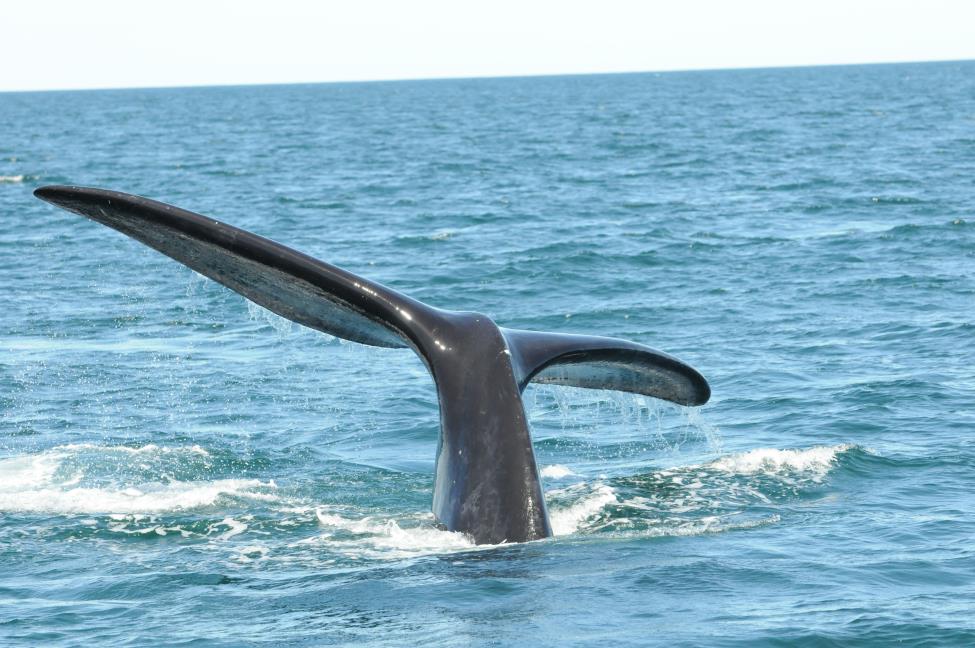
North Atlantic right whale #3245 diving in the Bay of Fundy on August 9, 2016, displaying the excellent condition of his flukes
credit: New England Aquarium

North Atlantic right whale #3245 in the Gulf of St. Lawrence on July 27, 2018 with severe damage to the base of his flukes from his 2017 entanglement in fishing rope
credit: Canadian Whale Institute
The 2018 NARWC Report Card also contains the following information on injuries that were seen in 2018. "Between 01 January and 31 December 2018, 17 new injury of interest events were documented, 15 of which were entanglement related and two were vessel strikes. Of these 17, four exhibited declining condition coinciding with injury. The impact of injury on the health of nine whales was inconclusive. There were no visual indicators of injury impact on health condition for the remaining four newly injured whales. Fourteen whales previously on the monitoring list were removed, including five who became presumed dead and nine who exhibited stable health. As of 31 December 2018, the Serious Injury/Human Impact list includes 70 whales with 79 injuries documented from 17 March 2004 through 31 December 2018 (Table 6). The majority of the injuries are entanglement related (67/79, 84.8%) followed by vessel strikes (10/79, 12.7%). There are two whales on the list with injuries of unknown origin." We found information on the whales listed above throughout the year and from the NARWC report card but we only found information about #3296 on the Georgia DNR Flickr page in the caption below his picture as it was not listed in the report card. We don't have information on the other injured whales and hope that the NARWC starts to include all injuries so the public knows about each one.
We list 11 of the North Atlantic right whales that were seen injured. Of the 11 we list, 10 were identified in the North Atlantic Right Whale Catalog. Of these 10, at least five have been entangled before and two have been struck by boats before (one whale, #4091, already had rope and propeller scars when she was seen entangled). Of the 10, 8 of their mothers are known. Of these 8, six have been entangled at least once in their lives. One of them, One-Two (#1430) - the mother of #3296, had been entangled at least twice and was last seen with rope entangling her in 2003, most likely having died since then, possibly from the entanglement. Of the 10 whales identified, four of their grandmothers are known. Of these four, three have previous entanglements (one of them being #1142 who is on the list of active entanglements this year). Of the 10 whales identified, one of their great-grandmothers is known. The great-grandmother of #4146, Loligo (#1246), and she has been entangled at least once before.
Of the 10 identified whales (nine entanglements, one ship strike), nine of them join the 83% of North Atlantic right whales that have been entangled at least once and five of them join the 59% that have been entangled at least twice.[PDF] Of the identified mothers, 75% have been entangled at least once and of the identified grandmothers, 75% have been entangled at least once with 1 (100%) of their great-grandmothers being entangled.
The history of North Atlantic right whales has been a tragic and brutal one, they have suffered at the hands of humans for hundreds of years and as soon as one form of suffering ended when whale hunts were banned, new forms of suffering such as entanglement in fishing rope and ship strikes took over. The last legal killing of a North Atlantic right whale occurred on March 24, 1935 when a mother and calf pair were attacked by fishermen off the coast of Florida. They were both shot with rifles and the calf was harpooned but the mother stayed by her calf during the six hour hunt. The calf was killed but the mother, later given the catalog number #1045, had managed to survive and was sighted again in 1959. She was seen a few times over the years, including 1985 when she was photographed with scars from an entanglement, until her last sighting in 1995 when she was seen with a propeller wound to her head that most likely killed her shortly after. Her calf was killed and #1045 was shot, entangled in fishing rope and struck by a ship - all at the hands of humans. There was no gap, no reprieve for these whales. Their suffering has continued unabated and it has to stop. We can help these whales because the solutions to help them do exist.
North Atlantic right whales keep being killed and injured by humans, mostly through entanglements in fishing gear and ship strikes. This is not only tragic and causing an immense amount of pain, it's also driving them to extinction. The population dropped from an estimated 451 in 2016 to 411 at the end of 2017, no calves were sighted in 2018 and in addition to all the injuries listed above, there were three known deaths and researchers believe that only 1 out of 3 deaths of North Atlantic right whales are actually seen and some of these are most likely whales that are seen injured but are never seen again. As of the publishing of this report there are five new calves that have been born in 2019. These births give us hope but much more needs to be done to truly protect North Atlantic right whales.
To find out more about what is happening to North Atlantic and North Pacific right whales and how we can all take actions in our everyday lives to protect them, please visit our Facts and Action sections on our website. We also post updates and pictures on Facebook, Tumblr and Twitter.